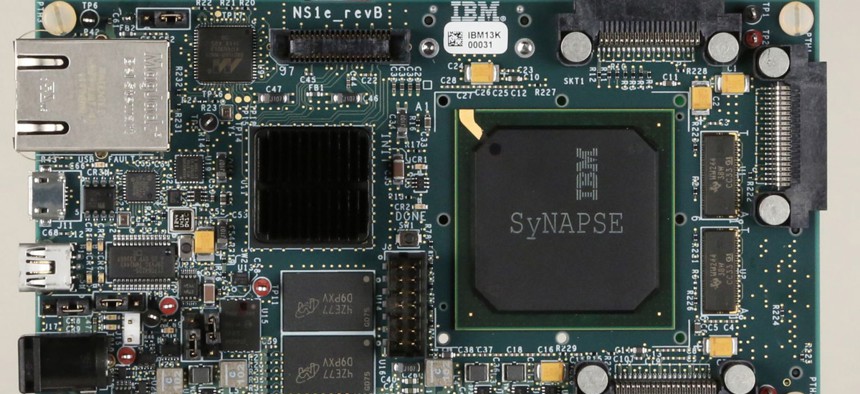A Digital Rat Brain Could Power Future Smartphones

One of IBM's brain chips. Flickr user IBM Research
Rather than a traditional computer, these computer chips are designed to work like neurons.
In August 2014, IBM announced that it had built a “brain-inspired” computer chip—essentially a computer that was wired like an organic brain, rather than a traditional computer. These chips are designed to work like neurons—the brain’s nerve cells. Wired reported on Aug. 17 that the team working on the brain chips recently hit a new milestone—a system has about 48 million digital neurons, which is roughly as many as found in the brain of a rodent.
Dharmendra Modha, the lead researcher on the project, recently told Quartz that he sees the future of computing being composed of two types of computers—traditional, logical computers, and synaptic brain computers—working together in a sort of left brain-right brain symbiosis to create systems that were previously unimaginable.
“Existing computers as really fast calculators,” Modha said.

While current chips are excellent at analyzing information in sequential order, the new “neuromorphic” types of chips Modha’s team are working on are better suited to finding patterns in information—like the right side of the brain. The chips’s design, with digital neurons communicating over digital versions of synapses, result in more powerful chips that need less power to run. Traditional chips follow instructions, whereas IBM’s new chip manages “spikes”—rather like spikes in electrical activity in an organic brain. The spikes are like a single bit of information, passing between neurons.
“Together, this creates this truly path-breaking architecture that can process sensory data in real time while consuming minimal energy in a mobile phone factor,” Modha said.
IBM held a bootcamp to explain to government agencies, researchers, and universities how its chips work, and how to build apps using them. As the chips aren’t wired like traditional computer chips, they needed their own programming language, which the team designed, and is now showing to the world.
For these chips, “the old mindset would be a square peg round hole,” Modha said.
Back in 2012, Modha’s team announced it was on the path to building a brain chip at the scale of a bee’s brain, which could play Pong about as well as a human. Three years later, the team has upped the power of its brain chip to the brain of a rodent, but there’s no word on whether it’s mastered any newer videogames.
Modha said his team’s goal is to build a “brain in a shoebox,” with over 10 billion synapses, consuming less than 1 kilowatt hour of power—the minuscule amount of power the human brain requires to work. He thinks this will be possible in less than a decade. (For reference, a human brain has about 100 billion synapses.) A computer with the intricacy and power of a human brain is likely still decades away, Modha said.
“The complexity and beauty of neurons in nature dwarfs the imagination,” he added.
In the future, as cognitive computing systems like IBM’s own Watson likely wrangle more and more of the endless torrents of data that the world produces, more powerful computers that can solve problems in novel ways will be needed. As Wired pointed out, Future versions of Siri or Google Now could be powered by neuromorphic chips like Modha’s, where natural language processing (NLP)—a computer’s ability to understand you when you speak to it—happens on the device, and doesn’t require an internet connection to a server farm half way around the world that’s devoted just to NLP.
This project, however, is not yet a digital brain, capable of producing the intelligence of a rat. Rather, it’s a system inspired by the way a rat’s brain is wired. But who knows where it could lead as research continues.
“The best way to predict the future is to invent it,” Modha said of his work. “That’s been my mantra.”
NEXT STORY: ICANN handoff officially delayed





